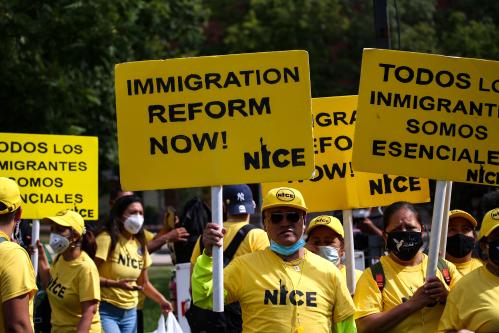Friday’s jobs report was an optimistic signal after a string of disappointing reports the past few months. As the worst effect of the delta variant waned, hiring picked up—albeit not across every demographic group. However, one group was conspicuously missing from the Bureau of Labor Statistics (BLS) jobs report, as they are every month: Native Americans.
Due to issues around sample size, the BLS does not report monthly jobs numbers for American Indians and Alaska Natives (referred to collectively in this piece as Native Americans).[1] As a result, Native Americans are largely left out of the important discussion when it comes to economic well-being in the United States—another form of erasure for a group that must continually contend with marginalization and exclusion in U.S. society.
This month, the absence is particularly conspicuous given that November is Native American Heritage Month, and it lays bare how far the U.S. government still has to go to give the Indigenous Peoples who reside here equal treatment to other residents.
While this oversight would be harmful under any circumstances, it has become especially acute during a pandemic that has had disproportionately devastating human and economic effects on Native American communities. Indeed, economic analyses conducted over the past year have demonstrated how the economic inequalities Native Americans face have exacerbated the health challenges of the pandemic. Unfortunately, despite great work by Donna Fehr and Charles Golding at the Federal Reserve Bank of Minneapolis showing that Native Americans had some of the most significant job losses at the start of the pandemic, the U.S. government is still not reporting a monthly baseline on how they are faring.
To help fill in the gap, we have here compiled the prime-age (ages 25-54) employment-to-population ratio (EPOP) for Native Americans since the start of 2020, pulled from the Census Bureau’s Current Population Survey (CPS). For this measure, we use all Native American racial combinations, not just workers identifying as American Indian and Alaska Native alone. This distinction is important because, according to the Census Bureau, 61% of Native Americans identify as two or more races—the highest rate of any census-defined racial group—a function of 400-plus years of colonization and displacement. To provide further context, we compare Native American EPOP to both non-Native white and non-Native Black EPOP.[2]
As Figure 1 below shows, EPOP for prime-age Native American workers lagged prime-age EPOP for both white and Black workers heading into the pandemic, and fell to levels lower than both white and Black workers at the height of the pandemic downturn in April 2020.

As the recovery began, Native American EPOP converged with Black workers throughout the summer of 2020. However, it began to lag again soon after, falling as much as 6 percentage points below Black workers and over 12 percentage points below white workers by January 2021. Since then, Native American employment growth has picked up: By September 2021, Native American EPOP had converged with Black workers and had actually surpassed the level that Native American workers were at before the pandemic. Still, Native American EPOP remained nearly 5 percentage points behind white workers and over 7 percentage points below where white workers were pre-pandemic.
However, even that story obscures differences among Native Americans. The CPS data fortunately allows researchers to begin exploring how mixed-race identity may influence Native Americans in the U.S. labor market. While sample sizes for many of the racial identification combinations are too small to draw meaningful conclusions, one that stands out is the distinction between individuals identifying as both American Indian or Alaska Native and white compared to other Native Americans. Across most months, individuals who identify as American Indian or Alaska Native and white tend to have higher employment levels compared to individuals who identify as either American Indian or Alaska Native alone or in combination with some other race.

This raises important questions about the effects of whiteness and structural racism overall in the U.S. economy. While further research is necessary, this discrepancy could be a function of a variety of different factors, from the wealth gap that white Americans have over other racial groups, to the advantages conferred by presenting as white in professional settings, or any of a variety of other structural advantages that white Americans have in the labor market.
Native Americans are facing more economic stressors than all other racial/ethnic groups
The overall employment data presented above aligns with newly published findings showing that, since the start of the pandemic, Native American communities have been the most economically stressed of any racial/ethnic group.
We draw from the African American Research Collaborative/Commonwealth Fund American COVID-19 Vaccine Poll, an extensive, diverse national survey with several measures of economic stress to augment the findings from the aggregate data. There were 12,887 participants who completed the overall survey between May 7 and June 7, 2021, and thanks to the Robert Wood Johnson Foundation’s support, there is a large sample of Native Americans (n=1,921). An extensive discussion of the survey methodology is detailed here.
Although the primary focus of the survey was to identify messaging to help improve vaccination uptake across the nation, the survey also tracked economic stressors, such as loss of health insurance, employment, and other financial struggles. As reflected in the figure below, Native Americans reported having economic stress to a greater extent than the other major racial and ethnic groups. According to the survey, the Native American population is leading the country in job losses due to the pandemic. Nearly a third (29%) of Native Americans in the survey reported that they had lost their job in the last year due to COVID-19. This is 11% higher than the overall sample, 13% higher than non-Hispanic white people, and higher than all other racial and ethnic minorities. Similarly, Native Americans are the group most likely to report that they were currently unemployed and looking for work—28% for Native Americans compared to 18% overall.
There is a similar pattern for other indicators of economic stress in the survey. Nearly 40% of the Native American population had their work hours or pay cut over the past year, significantly higher (+11%) than the overall sample average and all other subgroups. Native Americans are slightly less likely (-1%) than Latinos to have had to either close down their business or self-employment permanently or temporarily. Finally, 16% of Native Americans in the sample reported that they lost their health insurance over the past year, again higher than all other racial and ethnic groups. This inequality, in particular, will have lasting effects on health equity, as access to health insurance is one of the primary factors that drives health outcomes in the United States, and Native Americans already had the highest uninsured rate of any population in the United States.

The large sample size of the Native American population in the vaccination survey allows for some analysis of internal variation in job loss within this important yet often understudied population. Native Americans under the age of 30 were the most likely to report that they had lost their job (38%), as were Native Americans who live in urban areas (33%). Indicative of the economic stress facing Native American families, parents were more likely to have lost their job (+8%) relative to respondents who do not have any children in the home.
Recommendations to improve the economic well-being of Native Americans
To begin solving the challenges identified above, it will be essential to have both better data and better policy.
First and foremost, visibility and representation matter. Consistently including Native Americans (and other Indigenous Peoples in the United States, such as Native Hawaiians and Indigenous Pacific Islanders) in monthly reports on important economic indicators is an important baseline. By excluding these communities from essential datasets, the U.S. government is essentially treating Native Americans as if they do not exist.
If sample size is an issue, then Congress should provide more resources for collecting data on Native Americans in both hard-to-reach rural communities and undercounted urban areas. Native Americans are historically the most undercounted group on the census, which significantly distorts the overall data baseline that the Census Bureau uses in its surveys like the American Community Survey and Current Population Survey. That, combined with Native Americans being a relatively small share of the population, leads the Census Bureau to use sample sizes that are too small to do substantial subpopulation analysis.
However, just providing more resources for the federal government to collect data won’t be enough. In fact, prioritizing better data collection for Native nations in the U.S., and putting data collection in the hands of Native nations themselves, has been a consistent demand of Tribal governments across the U.S. With this, there is a growing Indigenous data-sovereignty movement that policymakers should embed in their work with Native nations. For example, the federal government should provide more resources for Native nations to collect their own data on their own terms and use it to meet their own needs. During efforts like the decennial census, the federal government could provide more resources for Native nations to carry out their own data collection and analysis for their citizens and within their own territories.
Ultimately, the Census Bureau may even want to consider working in partnership with Native nations to redefine how they are measuring Native American identity completely. The U.S. census relies on self-identification for individuals to classify their racial and ethnic category, but this is not sufficient for Native American identification. Native nations have an inherent right to define Tribal citizenship themselves, though historically federal policies sought to define Native American identity in terms of blood quantum in an effort to reinforce racist discourses othering non-white people and perpetuating a white supremacist racial order.
Today, Native nations use a variety of methods to recognize their populations, including language, residence, cultural affiliation, recognition by a community, and degree of “blood” and/or genealogical lines of descent. These methods employed by Native nations do not fit neatly into typical American definitions of “race.” Given the inherent rights of Native nations to identify their own populations, the Census Bureau should consider decoupling its data collection on Native American ancestry and citizenship entirely from its data collection on race. Doing so may validate even better the idea that Native Americans are not a single monolithic “race,” and, in fact, are a diverse collection of people from a variety of ethnic and cultural backgrounds.
Beyond better data, and data driven by Native nations, the federal government needs to move beyond paternalistic policies that have dominated federal law and policy and prioritize working with and supporting Native nations as they rebuild their economies. As one of the authors here has written previously, the Build Back Better Framework proposed by the Biden administration makes essential and significant—albeit still insufficient—investments to meet some of the most acute challenges facing Indian Country. In particular, the bill’s potential investments in protecting the environment and climate, expanding health-care coverage, building more housing, and investing in both urban and rural communities are essential. However, there remains more work to be done to fulfil the full trust and treaty obligations of the U.S. government to Native nations. These range from scaling up physical infrastructure investments in areas like clean water and broadband, to repatriating lands stolen by the U.S. government.
Friday’s jobs report shows that real progress is happening in the economic recovery. However, it’s impossible to build a truly inclusive recovery if some groups are wholesale excluded from the discussion. It’s important, then, that we talk about Native Americans not just during November, but every month—both in the stories we tell and in the data we report.
Gabriel Sanchez, PhD, is a David M. Rubenstein Fellow in Governance Studies at Brookings and a founding member of the Native American Budget and Policy Institute at the University of New Mexico.
Robert Maxim (Mashpee Wampanoag) is a senior research associate in Brookings Metro.
Raymond Foxworth (Navajo Nation), PhD, is visiting scholar in the department of political science at the University of New Mexico and serves as vice president of First Nations Development Institute.
Notes
[1] We use the term “Native American” in this blog post given that survey research consistently finds that this population prefers this pan-ethnic term.
[2] For different racial categories in our EPOP calculations, we do not disaggregate out Latino or Hispanic respondents, consistent with Fehr and Godling’s approach. The Census Bureau’s “Hispanic or Latino origin” categorization and subcategorizations make it impossible to determine if a given individual is an Indigenous person, a person descended from one of the various European nations that colonized what is today known as Latin America, or a mixture of both. In this regard, the Census Bureau’s Hispanic or Latino origin category actually underscores how current U.S. data collection practices are unhelpful for measuring the well-being of Indigenous people.









Commentary
The monthly jobs report ignores Native Americans. How are they faring economically?
November 10, 2021